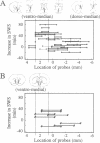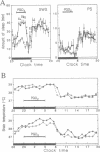Abstract
The site of action for the sleep-promoting effect of prostaglandin (PG) D2 was extensively examined in the brain of adult male rats (n = 231). PGD2 was administered at 100 pmol/0.2 microliter per min for 6 hr (2300-0500 hr) through chronically implanted microdialysis probes or infusion cannulae. Among the administrations of PDG2 by dialysis probes (n = 176), only those (n = 8) to a ventro-rostral part of the basal forebrain by the probes implanted on the midline consistently increased slow-wave sleep (SWS), by 51 +/- 6 min (mean +/- SEM) above the baseline value (111 +/- 11 min). Since this area is separated by a cleft into right and left regions, the results were interpreted to mean that, through this cleft, PGD2 diffused in the subarachnoid space over the adjacent ventral surface, where it had the effect of promoting sleep. When PGD2 was directly infused into the subarachnoid space (n = 55), extraordinary increases exceeding 90 min were consistently attained for the SWS at sites located between 0.5 and 2 mm rostral to the bregma and between 0 and 1.2 mm lateral to the midline defined according to the stereotaxic coordinates adopted from the brain atlas of Paxinos and Watson [Paxinos, G. & Watson, C. (1986) The Rat Brain in Stereotaxic Coordinates (Academic, San Diego)]. Thus, we demarcated a "PGD2-sensitive, sleep-promoting zone" within this region in the ventral surface of the rostral basal forebrain. During the bilateral infusion of PGD2 into the subarachnoid space of this zone, the hourly mean SWS level of the nocturnal animals (n = 6) in the night reached the maximum at the second hour of the infusion period; this maximum hourly SWS level, corresponding to the daytime level of the same animals, lasted until the end of PGD2 infusion.
Full text
PDF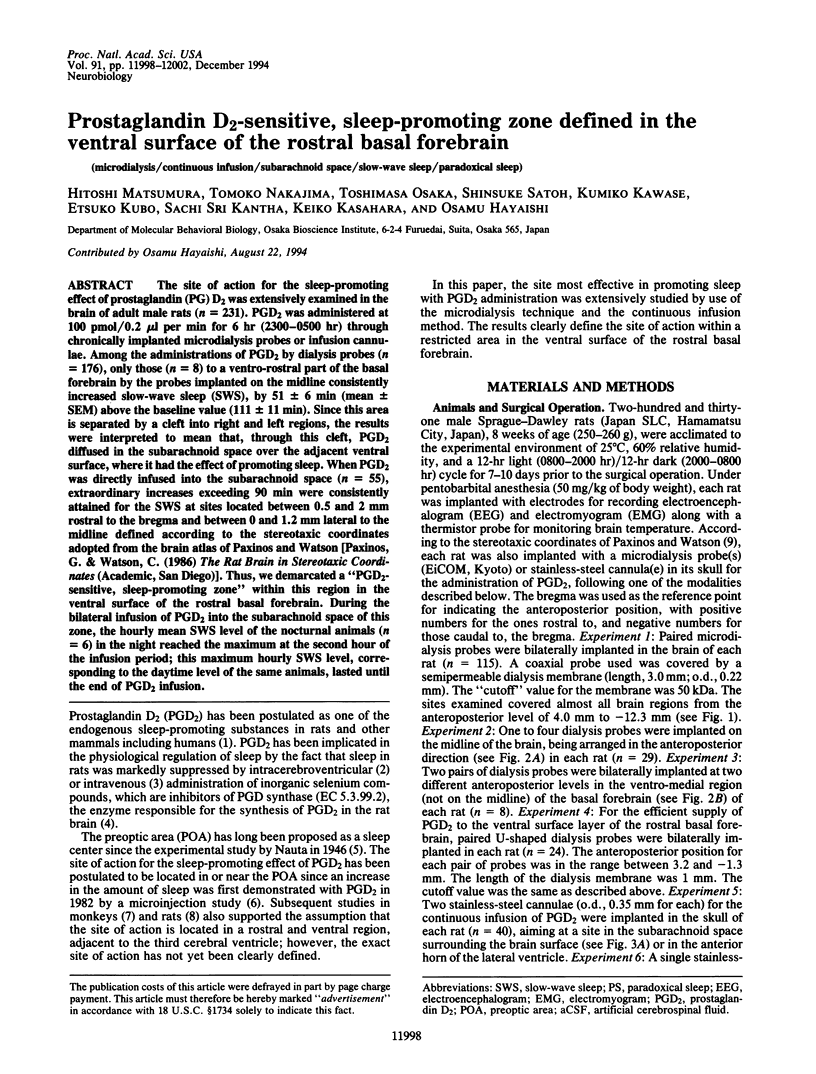
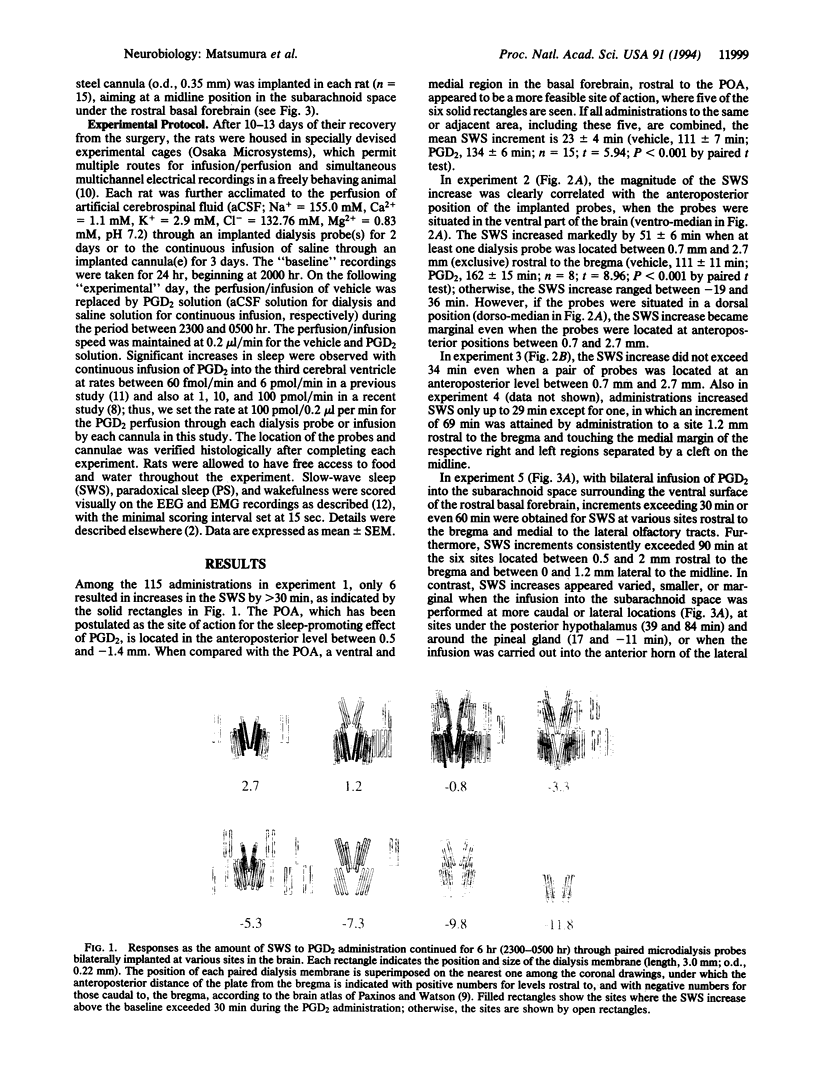

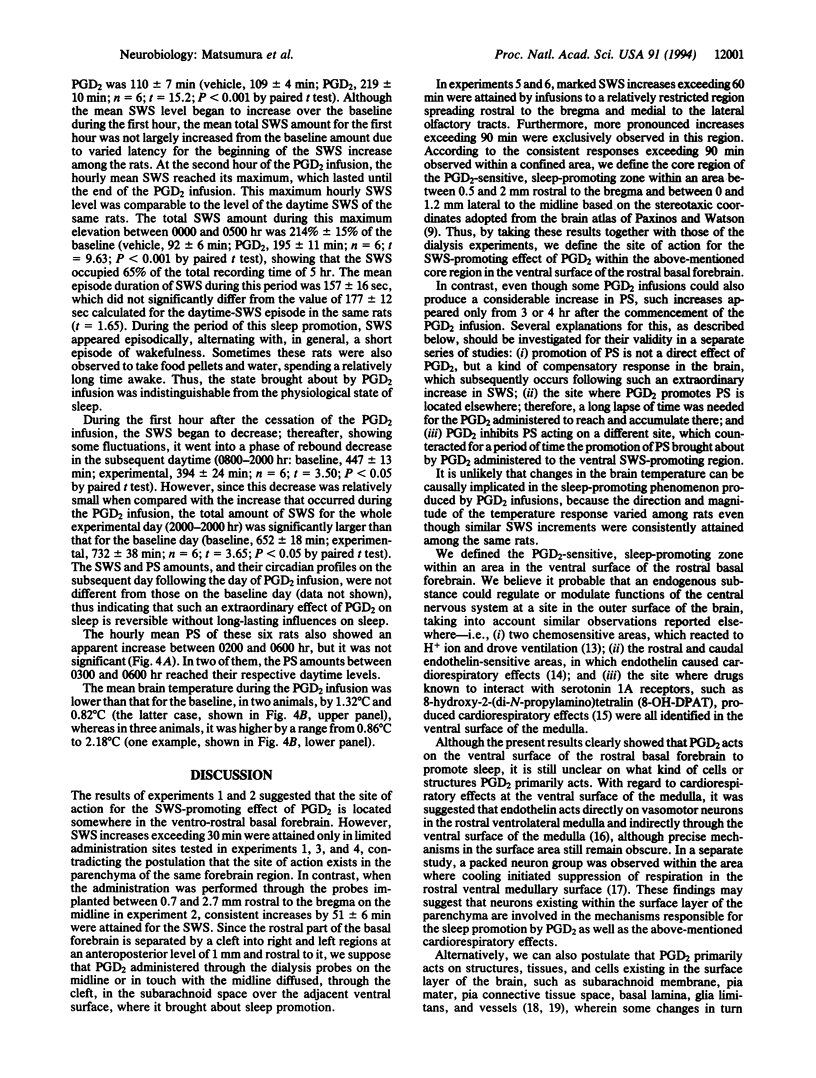
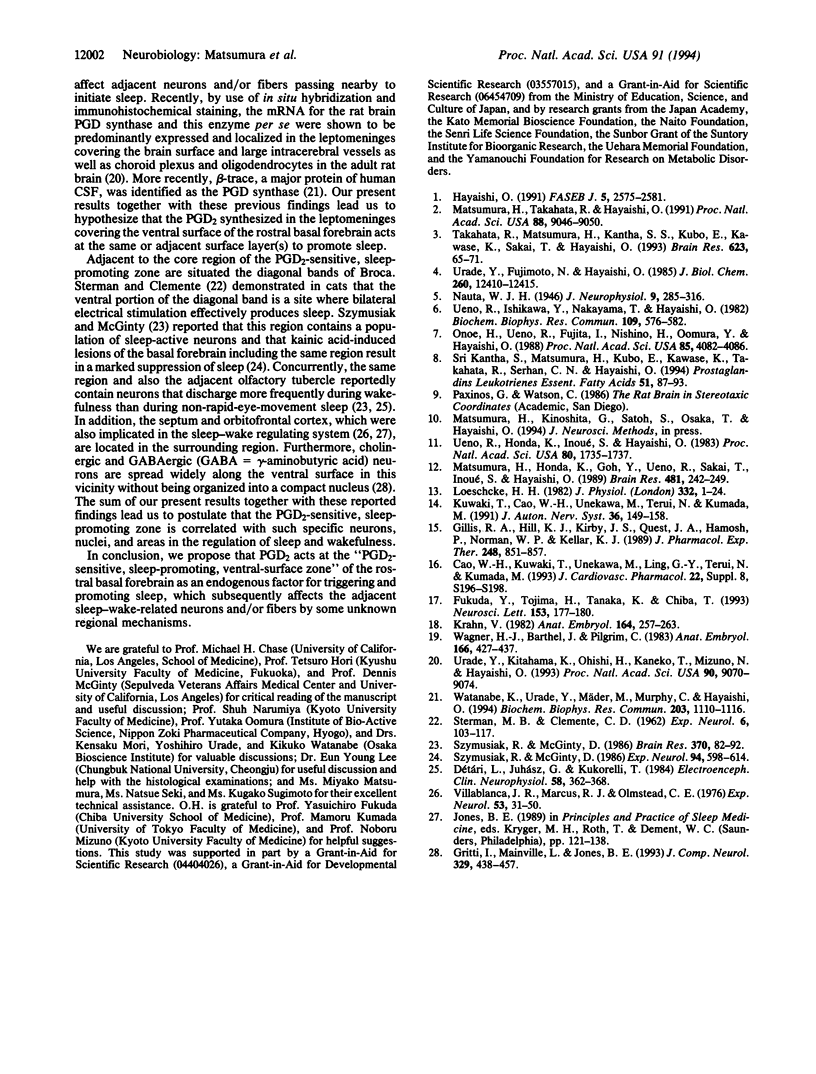
Images in this article
Selected References
These references are in PubMed. This may not be the complete list of references from this article.
- Cao W. H., Kuwaki T., Unekawa M., Ling G. Y., Terui N., Kumada M. Action of endothelin-1 on vasomotor neurons in rat rostral ventrolateral medulla. J Cardiovasc Pharmacol. 1993;22 (Suppl 8):S196–S198. doi: 10.1097/00005344-199322008-00053. [DOI] [PubMed] [Google Scholar]
- Détári L., Juhász G., Kukorelli T. Firing properties of cat basal forebrain neurones during sleep-wakefulness cycle. Electroencephalogr Clin Neurophysiol. 1984 Oct;58(4):362–368. doi: 10.1016/0013-4694(84)90062-2. [DOI] [PubMed] [Google Scholar]
- Fukuda Y., Tojima H., Tanaka K., Chiba T. Respiratory suppression by focal cooling of ventral medullary surface in anesthetized rats; functional and neuroanatomical correlate. Neurosci Lett. 1993 Apr 30;153(2):177–180. doi: 10.1016/0304-3940(93)90316-d. [DOI] [PubMed] [Google Scholar]
- Gillis R. A., Hill K. J., Kirby J. S., Quest J. A., Hamosh P., Norman W. P., Kellar K. J. Effect of activation of central nervous system serotonin 1A receptors on cardiorespiratory function. J Pharmacol Exp Ther. 1989 Feb;248(2):851–857. [PubMed] [Google Scholar]
- Gritti I., Mainville L., Jones B. E. Codistribution of GABA- with acetylcholine-synthesizing neurons in the basal forebrain of the rat. J Comp Neurol. 1993 Mar 22;329(4):438–457. doi: 10.1002/cne.903290403. [DOI] [PubMed] [Google Scholar]
- Hayaishi O. Molecular mechanisms of sleep-wake regulation: roles of prostaglandins D2 and E2. FASEB J. 1991 Aug;5(11):2575–2581. [PubMed] [Google Scholar]
- Krahn V. The pia mater at the site of the entry of blood vessels into the central nervous system. Anat Embryol (Berl) 1982;164(2):257–263. doi: 10.1007/BF00318509. [DOI] [PubMed] [Google Scholar]
- Kuwaki T., Cao W. H., Unekawa M., Terui N., Kumada M. Endothelin-sensitive areas in the ventral surface of the rat medulla. J Auton Nerv Syst. 1991 Nov;36(2):149–158. doi: 10.1016/0165-1838(91)90111-f. [DOI] [PubMed] [Google Scholar]
- Loeschcke H. H. Central chemosensitivity and the reaction theory. J Physiol. 1982 Nov;332:1–24. doi: 10.1113/jphysiol.1982.sp014397. [DOI] [PMC free article] [PubMed] [Google Scholar]
- Matsumura H., Honda K., Goh Y., Ueno R., Sakai T., Inoué S., Hayaishi O. Awaking effect of prostaglandin E2 in freely moving rats. Brain Res. 1989 Mar 6;481(2):242–249. doi: 10.1016/0006-8993(89)90800-7. [DOI] [PubMed] [Google Scholar]
- Matsumura H., Takahata R., Hayaishi O. Inhibition of sleep in rats by inorganic selenium compounds, inhibitors of prostaglandin D synthase. Proc Natl Acad Sci U S A. 1991 Oct 15;88(20):9046–9050. doi: 10.1073/pnas.88.20.9046. [DOI] [PMC free article] [PubMed] [Google Scholar]
- Onoe H., Ueno R., Fujita I., Nishino H., Oomura Y., Hayaishi O. Prostaglandin D2, a cerebral sleep-inducing substance in monkeys. Proc Natl Acad Sci U S A. 1988 Jun;85(11):4082–4086. doi: 10.1073/pnas.85.11.4082. [DOI] [PMC free article] [PubMed] [Google Scholar]
- STERMAN M. B., CLEMENTE C. D. Forebrain inhibitory mechanisms: sleep patterns induced by basal forebrain stimulation in the behaving cat. Exp Neurol. 1962 Aug;6:103–117. doi: 10.1016/0014-4886(62)90081-x. [DOI] [PubMed] [Google Scholar]
- Sri Kantha S., Matsumura H., Kubo E., Kawase K., Takahata R., Serhan C. N., Hayaishi O. Effects of prostaglandin D2, lipoxins and leukotrienes on sleep and brain temperature of rats. Prostaglandins Leukot Essent Fatty Acids. 1994 Aug;51(2):87–93. doi: 10.1016/0952-3278(94)90083-3. [DOI] [PubMed] [Google Scholar]
- Szymusiak R., McGinty D. Sleep suppression following kainic acid-induced lesions of the basal forebrain. Exp Neurol. 1986 Dec;94(3):598–614. doi: 10.1016/0014-4886(86)90240-2. [DOI] [PubMed] [Google Scholar]
- Szymusiak R., McGinty D. Sleep-related neuronal discharge in the basal forebrain of cats. Brain Res. 1986 Apr 2;370(1):82–92. doi: 10.1016/0006-8993(86)91107-8. [DOI] [PubMed] [Google Scholar]
- Takahata R., Matsumura H., Kantha S. S., Kubo E., Kawase K., Sakai T., Hayaishi O. Intravenous administration of inorganic selenium compounds, inhibitors of prostaglandin D synthase, inhibits sleep in freely moving rats. Brain Res. 1993 Sep 24;623(1):65–71. doi: 10.1016/0006-8993(93)90010-k. [DOI] [PubMed] [Google Scholar]
- Ueno R., Honda K., Inoué S., Hayaishi O. Prostaglandin D2, a cerebral sleep-inducing substance in rats. Proc Natl Acad Sci U S A. 1983 Mar;80(6):1735–1737. doi: 10.1073/pnas.80.6.1735. [DOI] [PMC free article] [PubMed] [Google Scholar]
- Ueno R., Ishikawa Y., Nakayama T., Hayaishi O. Prostaglandin D2 induces sleep when microinjected into the preoptic area of conscious rats. Biochem Biophys Res Commun. 1982 Nov 30;109(2):576–582. doi: 10.1016/0006-291x(82)91760-0. [DOI] [PubMed] [Google Scholar]
- Urade Y., Fujimoto N., Hayaishi O. Purification and characterization of rat brain prostaglandin D synthetase. J Biol Chem. 1985 Oct 15;260(23):12410–12415. [PubMed] [Google Scholar]
- Urade Y., Kitahama K., Ohishi H., Kaneko T., Mizuno N., Hayaishi O. Dominant expression of mRNA for prostaglandin D synthase in leptomeninges, choroid plexus, and oligodendrocytes of the adult rat brain. Proc Natl Acad Sci U S A. 1993 Oct 1;90(19):9070–9074. doi: 10.1073/pnas.90.19.9070. [DOI] [PMC free article] [PubMed] [Google Scholar]
- Villablanca J. R., Marcus R. J., Olmstead C. E. Effects of caudate nuclei or frontal cortex ablations in cats. II. Sleep-wakefulness, EEG, and motor activity. Exp Neurol. 1976 Oct;53(1):31–50. doi: 10.1016/0014-4886(76)90279-x. [DOI] [PubMed] [Google Scholar]
- Wagner H. J., Barthel J., Pilgrim C. Permeability of the external glial limiting membrane of rat parietal cortex. Anat Embryol (Berl) 1983;166(3):427–437. doi: 10.1007/BF00305928. [DOI] [PubMed] [Google Scholar]
- Watanabe K., Urade Y., Mäder M., Murphy C., Hayaishi O. Identification of beta-trace as prostaglandin D synthase. Biochem Biophys Res Commun. 1994 Sep 15;203(2):1110–1116. doi: 10.1006/bbrc.1994.2297. [DOI] [PubMed] [Google Scholar]




